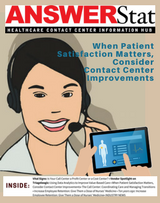By Allison Hart
There is no question that hospitals and health systems strive to deliver the best possible clinical care. But today, organizations aren’t just focusing on providing exceptional clinical services; they also invest resources into efforts aimed at driving superior healthcare experiences at every touchpoint. For hospitals, maintaining high patient satisfaction is more important than ever, primarily because the financial impact of patient experiences has increased due to consumerization and value-based payment programs.
As a result, patient experience has become a force behind process improvements and facility upgrades. The push to improve patient experiences exists in cafeteria and dining service improvements, luxury hospital suites, and even redesigned hospital gowns. But what is surprising is that while hospital and health system teams vigorously work to make their facilities more welcoming and comfortable, many organizations are unknowingly greeting patients who call into their contact center in a much less welcoming way.
To deliver more uniformly satisfying patient experiences, hospitals and healthcare systems can take actions to optimize their contact center—the place where many patient experiences initially begin.
Calling a healthcare provider or organization shouldn’t be difficult or unpleasant for patients—even if that organization is a large hospital or health system. However, patients frequently run into issues that lead to frustration, when they attempt to connect with their healthcare team because they:
- Do not know which phone number to call to find the help they need
- Are transferred or put on hold multiple times
- Must repeat personal information or reason for their call several times
- Have trouble navigating automated options
- Struggle to find the resolution they need in a timely manner
- Do not feel their call is a priority
At least one in two patient callers will get “lost” in their healthcare provider’s automated phone system when calling into a hospital or large provider organization. That means at least one in two patients will not have a positive experience when they attempt to communicate about their healthcare needs.
Difficult-to-navigate automated phone systems require patients to be on the phone for longer periods of time. But patients say they appreciate efficient communication experiences. West surveyed more than 500 U.S. consumers to better understand communication preferences and how to define high-quality customer experiences.
Survey responses revealed that when customers or patients initiate an interaction, 77 percent of them rate speed to resolution as the best indicator of good service. Multiple transfers, repetitive conversations, and other confusing issues extend call times and hurt patient satisfaction.
Regularly evaluating the functionality, efficiency, and ease of use of automated phone systems is important for creating positive and welcoming communication experiences. But few healthcare organizations prioritize regular contact center testing. In fact, just over half of healthcare organizations occasionally review their automated phone systems to ensure they work correctly and provide value to patients.
Beyond testing the functionality of their automated systems, hospitals and health systems that want to deliver high-quality experiences can work to accomplish the following items.
Ensure Their Contact Center Serves as a Single Entryway for Their Organization
With a single point of entry for all patients, it is easier for organizations to guarantee every patient experiences a consistently branded user experience. It also means less confusion and frustration for callers and staff.
Routing calls through an automated centralized phone system increases efficiency. Overall, hospitals have more control over each caller’s experience when all calls route through one main gateway.
Offer Intelligent Predictive Interactive Voice Response
Interactive voice response (IVR) systems allow hospitals to automate call routing and handle higher volumes of calls. But IVR must be intelligent enough to make navigation easier for patients by detecting what they need.
Ideally, when a patient calls a hospital, the IVR system will authenticate the patient, identify possible reasons for their call, and connect them to the appropriate destination. The right IVR technology will not only make communications more efficient but also more patient centered.
Implement Automatic Data Pass with Every Transferred Call
Healthcare staff can better and more quickly assist callers if background information transfers with each incoming call. Without automatic data pass there is typically a lot of duplication during communication. Staff may end up asking patients for information they provided already to another representative during the same call.
Rather than having staff repeat work by asking questions about information already collected, teams can rely on technology to automatically provide necessary data. This helps patients feel as though they are heard and that the individuals they speak with are knowledgeable and focused on helping them.
Conclusion: A call to a hospital’s contact center is sometimes a patient’s first contact with the organization. Investing in contact center optimization is a must for creating a welcoming and satisfactory first impression. Even for patients who are not new to an organization, a hassle-free experience is appreciated. Giving patients positive communication experiences is not difficult; it simply requires that hospitals and health systems dedicate a bit more attention to call center functionality and optimization.
Allison Hart is an advocate for utilizing technology-enabled communications to engage and activate patients beyond the clinical setting. She leads thought leadership efforts for West’s TeleVox Solutions, promoting the idea that engaging with patients between healthcare appointments in meaningful ways will encourage and inspire them to follow and embrace treatment plans—and that activating these positive behaviors ultimately leads to better outcomes for both healthcare organizations and patients. Hart currently serves as vice president of marketing for TeleVox Solutions at West, where the healthcare mission is to help organizations harness communications to expand the boundaries of where, when, and how healthcare is delivered.
